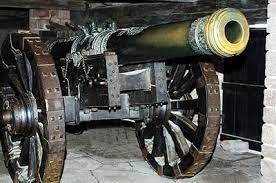Key Point: The Minion Cannon was a small and versatile artillery piece widely used in naval warfare and on land. It was known for its portability and effectiveness in both military and naval operations.
Step with me back in time to the era of immense firepower and groundbreaking innovation. There a petite but powerful weapon made its mark on the battlefield. The Minnion cannon.
Unleashing devastation with its accuracy and range, this compact artillery piece revolutionized warfare, forever changing the tides of conflict. Join me as I delve into the fascinating history and engineering prowess behind this miniature powerhouse, and the impact it had on the battlefield.
Let’s begin with a short introduction to its origin …
Origin Of The Minnion Cannon
The origin of the Minion Cannon can be traced back to the 16th century, during a time when advancements in artillery technology were taking place. Engineers and military strategists sought to develop a more mobile and versatile cannon that could effectively support troops on the battlefield. It was during this period that the Dutch engineer Simon Stevin proposed a revolutionary idea.
Stevin envisioned a smaller cannon that could be easily transported and maneuvered. His concept aimed to address the limitations of larger cannons, such as the Culverin and Basilisk, which were heavy and less agile. The objective was to create a cannon that could adapt to various combat scenarios and provide greater flexibility to military forces.
Inspired by Stevin’s innovative idea, the Minion Cannon was born. This new artillery piece boasted a compact design and reduced weight, enabling it to be swiftly deployed and repositioned on the battlefield. The Minion Cannon’s smaller size made it more manageable. Which allowed for enhanced mobility and increased maneuverability in different types of terrain.
The development of the Minion Cannon marked a significant departure from traditional cannon designs. It represented a response to the changing nature of warfare, where adaptability and versatility played crucial roles in achieving success on the battlefield.
The smaller size of the Minion Cannon also brought about strategic advantages. It could be easily transported by horse-drawn carriages or even carried by a group of soldiers. This mobility was a game-changer. Why is that you ask? Well, it allowed armies to position artillery support in strategic locations, providing crucial firepower where it was most needed during battles and sieges.
So the Minion Cannon quickly gained recognition for its effectiveness in warfare, you will see why in just a moment.
Now, let us go through a quick description of the Minnie Cannon.
Description Of The Minion Cannon

The Minion Cannon, known for its compact size and mobility, was a formidable artillery weapon employed during the 17th century. Made primarily of bronze, this cannon possessed a robust yet portable design. It featured a smoothbore barrel, measuring approximately 6 feet in length, and had a weight of around 1,000 kilograms. Its sleek appearance and manageable size made the Minion Cannon a valuable asset on the battlefield.
Now, let’s check out what projectiles this minion cannon fired …
Projectiles Of The Minion Cannon
The Minion Cannon fired projectiles of varying calibers, adapting to the needs of different engagements. It could launch cannonballs ranging from 3 to 6 inches in diameter, delivering devastating blows to enemy fortifications and infantry formations alike. The sheer force and destructive power of these projectiles made the Minion Cannon a fearsome weapon, capable of causing significant damage to opposing forces.
Use Of The Minion Cannon in Battle
The Minion Cannon played a crucial role in numerous famous battles. One notable engagement where the Minion Cannon made its mark was the Battle of Breitenfeld in 1631. Deployed by the Swedish army under the command of King Gustavus Adolphus, the Minion Cannon provided crucial firepower, tearing through enemy lines and turning the tide of the battle. This victory showcased the effectiveness of the Minion Cannon and solidified its reputation as a game-changing artillery piece.
This leads us perfectly to …
Impact On Historical Events
The utilization of the Minion Cannon had a profound impact on the course of events in warfare. Its superior range and firepower allowed armies to breach fortified positions and break enemy lines, altering the outcome of battles. By enabling more effective siege warfare, the Minion Cannon revolutionized the military tactics of the time, forcing commanders to adapt their strategies and fortifications accordingly.
However, despite its strengths, the Minion Cannon did possess certain disadvantages.
Decline Of The Minion Cannon
Here are a few disadvantages that ultimately led to its downfall.
Its relatively short range compared to later artillery advancements restricted its effectiveness in certain situations. Additionally, the time required for reloading limited the rate of fire, made it susceptible to counterattacks during this vulnerable period.
So as military technology advanced, cannons with longer ranges and improved reloading mechanisms eventually surpassed the Minion Cannon, leading to its gradual decline.
Successors To The Minion Cannon
Following the era of the Minion Cannon, subsequent developments in artillery led to the emergence of more advanced cannon designs. One notable successor was the Culverin Cannon, characterized by its longer range and enhanced precision. The Culverin Cannon became a staple in artillery arsenals, further evolving the field of artillery warfare.
In Conclusion
I would like to thank you for taking the time to read this article. I hope you learned a thing or two. And if you wish to see one of the first cannons used in Europe I suggest taking a look at my article on the Ribauldequin cannon.
Take care!
Sources:
“Artillery: An Illustrated History of its Impact” by Jeff Kinard